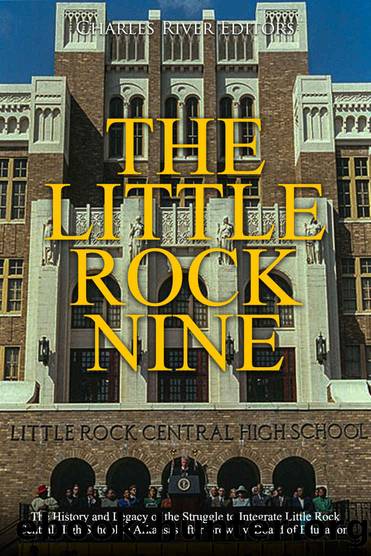The Little Rock Nine: The History and Legacy of the Struggle to Integrate Little Rock Central High School in Arkansas after Brown v. Board of Education by Charles River Editors

Author:Charles River Editors
Language: eng
Format: azw3
Publisher: Charles River Editors
Published: 2020-08-02T00:00:00+00:00
The Integration of the school
After the judgeâs order, Faubus recalled the National Guard from Central and left security to the local police, allowing the Little Rock Nine to make another attempt to enter school on Monday, September 23. Early that morning, the nine students met at Batesâ house to ride to school together, driven by NAACP officials. Once they arrived, they were met by a throng of reporters and photographers, nearly 1,000 unruly protesters outside the school, and city and state police stationed around the campus. The students arrived at a side entrance to avoid the crowd in front, but the mob soon rushed over to where they were, yelling epithets and curses, and police stood behind sawhorse barricades to keep them at a distance.
The new students were rushed inside the building, through hallways, and to the principalâs office despite the angry, threatening voices which they could hear from inside the school. They were each assigned different homerooms and given a white staff member to guide them. Patillo was terrified, recalling, âThe angry voices shouting at me made it all the more difficult to find my way through these unfamiliar surroundings.â On the way to her homeroom, she was screamed at, slapped, and spat on. Inside her classroom, the other students moved away as she sat down, and one boy threatened to assault her, saying, âThey ainât nothing but animals.â In response, the teacher did nothing. The other students reported similar experiences.
While on a playing field in her next class, physical education, three white women from the Motherâs League saw Patillo, jumped the fence, and ran toward her shouting obscenities. The gym teacher helped her run toward the building, but she was tripped and narrowly escaped being attacked by a group of women and girls from her class.
During third period, the crowd of protesters broke through the barricades and made their way into the school. The black students were rushed to safety in the principalâs office. Patillo later remembered that she actually heard a school official say, âWe may have to let the mob have one of these kids so we can distract them long enough to get the others out.â The Little Rock police chief soon arrived to escort them to the mechanics classroomâs basement garage, where they were loaded into unmarked police cars and driven home. With that, their first day at Central High School had ended before noon, and the segregationists, armed with guns, ropes, and clubs, surged inside the school, dancing and shouting.
Meanwhile, Mayor Mann called on the federal government to intervene, sending a telegram to President Eisenhower. In response to what he called the âdisgraceful occurrences at Central High School,â including the severe beatings of three black reporters, Eisenhower vowed to use the full extent of his powers to prevent any further school integration violence in Little Rock and to ensure the courtâs orders were carried out in a televised address. He also issued an Executive Order, sending 1,000 US Army troops from the 101st Airborne Division to enforce integration and maintain order.
Download
This site does not store any files on its server. We only index and link to content provided by other sites. Please contact the content providers to delete copyright contents if any and email us, we'll remove relevant links or contents immediately.
| Africa | Americas |
| Arctic & Antarctica | Asia |
| Australia & Oceania | Europe |
| Middle East | Russia |
| United States | World |
| Ancient Civilizations | Military |
| Historical Study & Educational Resources |
Magic and Divination in Early Islam by Emilie Savage-Smith;(1498)
Ambition and Desire: The Dangerous Life of Josephine Bonaparte by Kate Williams(1342)
Bohemians, Bootleggers, Flappers, and Swells: The Best of Early Vanity Fair by Bohemians Bootleggers Flappers & Swells- The Best of Early Vanity Fair (epub)(1341)
Papillon by Henry Charrière(1305)
Twelve Caesars by Mary Beard(1253)
Operation Vengeance: The Astonishing Aerial Ambush That Changed World War II by Dan Hampton(1134)
What Really Happened: The Death of Hitler by Robert J. Hutchinson(1126)
London in the Twentieth Century by Jerry White(1110)
Time of the Magicians by Wolfram Eilenberger(1085)
Twilight of the Gods by Ian W. Toll(1083)
The Japanese by Christopher Harding(1081)
Lenin: A Biography by Robert Service(1041)
The Devil You Know by Charles M. Blow(983)
A Social History of the Media by Peter Burke & Peter Burke(936)
Freemasons for Dummies by Hodapp Christopher;(921)
Napolean Hill Collection by Napoleon Hill(901)
Henry III by David Carpenter;(890)
The Churchill Complex by Ian Buruma(879)
The Rise and Triumph of the Modern Self by Unknown(877)
